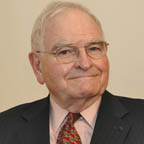Paul E. Gray: Difference between revisions
m (Text replace - "[[Category:Workplace diversity" to "[[Category:Workplace") |
m (Text replace - "[[Category:Engineering profession" to "[[Category:Profession") |
||
| Line 9: | Line 9: | ||
Dr. Gray was very active in Washington, D.C. as an advocate of engineering universities. He served four years on the White House Science Council and as a member on the Council's Panel on the Health of Universities.He was at the forefront in promoting open intellectual exchange with countries such as Japan, and he used his influence to lobby for increased public awareness of science and technology. An [[IEEE Fellow Grade History|IEEE Life Fellow]], Dr. Gray is a Professor of Electrical Engineering Emeritus and President Emeritus at MIT. | Dr. Gray was very active in Washington, D.C. as an advocate of engineering universities. He served four years on the White House Science Council and as a member on the Council's Panel on the Health of Universities.He was at the forefront in promoting open intellectual exchange with countries such as Japan, and he used his influence to lobby for increased public awareness of science and technology. An [[IEEE Fellow Grade History|IEEE Life Fellow]], Dr. Gray is a Professor of Electrical Engineering Emeritus and President Emeritus at MIT. | ||
[[Category: | [[Category:Profession|Gray]] [[Category:Engineering education|Gray]] [[Category:Workplace|Gray]] | ||
Revision as of 20:12, 23 July 2014
Biography
As an educator and expert in semiconductor electronics, Paul Edward Gray’s vision and leadership have advanced engineering education and practice around the globe. His innovative approaches at MIT, Cambridge, Mass., influenced generations of engineering leaders. His experience, knowledge and continued passion for education were evident in his various roles held at MIT, ranging from instructor, to dean, to president. In the 1980s he encouraged curriculum reforms that strengthened humanities, arts and social sciences. He championed for increased opportunities for women and minorities, and he was a strong advocate in providing financial assistance to all students in need.
Dr. Gray was a proponent of expanding undergraduate engineering education beyond the traditional core science subjects to better prepare engineering students for management roles. He strongly supported creation of the MIT Leaders for Manufacturing Programs to produce graduates with both engineering and leadership abilities. He was a champion of MIT’s Undergraduate Research Opportunities Program, which allowed students to join faculty research groups to apply their classroom learning and be exposed to real-world problems.
Dr. Gray was very active in Washington, D.C. as an advocate of engineering universities. He served four years on the White House Science Council and as a member on the Council's Panel on the Health of Universities.He was at the forefront in promoting open intellectual exchange with countries such as Japan, and he used his influence to lobby for increased public awareness of science and technology. An IEEE Life Fellow, Dr. Gray is a Professor of Electrical Engineering Emeritus and President Emeritus at MIT.
